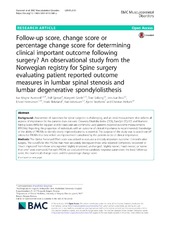| dc.contributor.author | Austevoll, Ivar Magne | en_US |
| dc.contributor.author | Gjestad, Rolf | en_US |
| dc.contributor.author | Grotle, Margreth | en_US |
| dc.contributor.author | Solberg, Tore | en_US |
| dc.contributor.author | Brox, Jens Ivar | en_US |
| dc.contributor.author | Hermansen, Erland | en_US |
| dc.contributor.author | Rekeland, Frode | en_US |
| dc.contributor.author | Indrekvam, Kari | en_US |
| dc.contributor.author | Storheim, Kjersti | en_US |
| dc.contributor.author | Hellum, Christian | en_US |
| dc.date.accessioned | 2020-06-23T12:47:09Z | |
| dc.date.available | 2020-06-23T12:47:09Z | |
| dc.date.issued | 2019-01-18 | |
| dc.Published | Austevoll IM, Gjestad R, Grotle M, Solberg T, Brox JI, Hermansen E, Rekeland F, Indrekvam K, Storheim K, Hellum C. Follow-up score, change score or percentage change score for determining clinical important outcome following surgery? An observational study from the Norwegian registry for Spine surgery evaluating patient reported outcome measures in lumbar spinal stenosis and lumbar degenerative spondylolisthesis. BMC Musculoskeletal Disorders. 2019;20:31 | eng |
| dc.identifier.issn | 1471-2474 | |
| dc.identifier.uri | https://hdl.handle.net/1956/22836 | |
| dc.description.abstract | Background: Assessment of outcomes for spinal surgeries is challenging, and an ideal measurement that reflects all aspects of importance for the patients does not exist. Oswestry Disability Index (ODI), EuroQol (EQ-5D) and Numeric Rating Scales (NRS) for leg pain and for back pain are commonly used patients reported outcome measurements (PROMs). Reporting the proportion of individuals with an outcome of clinical importance is recommended. Knowledge of the ability of PROMs to identify clearly improved patients is essential. The purpose of this study was to search cut-off criteria for PROMs that best reflect an improvement considered by the patients to be of clinical importance. Methods: The Global Perceived Effect scale was utilized to evaluate a clinically important outcome 12 months after surgery. The cut-offs for the PROMs that most accurately distinguish those who reported ‘completely recovered’ or ‘much improved’ from those who reported ‘slightly improved’, unchanged’, ‘slightly worse’, ‘much worse’, or ‘worse than ever’ were estimated. For each PROM, we evaluated three candidate response parameters: the (raw) follow-up score, the (numerical) change score, and the percentage change score. Results: We analysed 3859 patients with Lumbar Spinal Stenosis [(LSS); mean age 66; female gender 50%] and 617 patients with Lumbar Degenerative Spondylolisthesis [(LDS); mean age 67; 72% female gender]. The accuracy of identifying ‘completely recovered’ and ‘much better’ patients was generally high, but lower for EQ-5D than for the other PROMs. For all PROMs the accuracy was lower for the change score than for the follow-up score and the percentage change score, especially among patients with low and high PROM scores at baseline. The optimal threshold for a clinically important outcome was ≤24 for ODI, ≥0.69 for EQ-5D, ≤3 for NRS leg pain, and ≤ 4 for NRS back pain, and, for the percentage change score, ≥30% for ODI, ≥40% for NRS leg pain, and ≥ 33% for NRS back pain. The estimated cut-offs were similar for LSS and for LDS. Conclusion: For estimating a ‘success’ rate assessed by a PROM, we recommend using the follow-up score or the percentage change score. These scores reflected a clinically important outcome better than the change score. | en_US |
| dc.language.iso | eng | eng |
| dc.publisher | BioMed Central | eng |
| dc.rights | Attribution CC BY | eng |
| dc.rights.uri | http://creativecommons.org/licenses/by/4.0/ | eng |
| dc.title | Follow-up score, change score or percentage change score for determining clinical important outcome following surgery? An observational study from the Norwegian registry for Spine surgery evaluating patient reported outcome measures in lumbar spinal stenosis and lumbar degenerative spondylolisthesis | en_US |
| dc.type | Peer reviewed | |
| dc.type | Journal article | |
| dc.date.updated | 2019-12-10T18:38:55Z | |
| dc.description.version | publishedVersion | en_US |
| dc.rights.holder | Copyright 2019 The Authors | |
| dc.identifier.doi | https://doi.org/10.1186/s12891-018-2386-y | |
| dc.identifier.cristin | 1693764 | |
| dc.source.journal | BMC Musculoskeletal Disorders | |

